Yogyakarta, an Introduction
Indonesia Java International Destination Yogyakarta is the quintessential Indonesia city that personifies its sound, its sights, its smells. Often written as Jogjakarta or simply abbreviated to Jogja and Yogya, Jogjakarta is the name of the city as well as province in central Java, Indonesia. It holds the distinction of being the only Indonesian province that is still governed by a precolonial Sultanate, the Sultanate of Ngayogyakarta Hadiningrat. The city is known as a center of classical Javanese fine art and culture such as batik, ballet, drama, music, poetry and puppet shows. The official name of the Yogyakarta province is Special Region of Yogyakarta (Indonesian: Daerah Istimewa Yogyakarta, or DIY). The city of Yogyakarta is the capital of the province.
Yogyakarta History
The sultanate of Jogjakarta, formally the Sultanate of Ngayogyakarta Hadiningrat, was formed in 1755 when the Sultanate of Mataram was divided into two by the Dutch East India Company (VOC). The division created the Sultanate of Ngayogyakarta and the Sultanate of Surakarta, with the capitals being Yogyakarta and Surakarta respectively. Sultan Hamengkubuwono I of Yogyakarta built his new capital, centred around his palace, called Kraton, using the court of Surakarta as blueprint. By the time of his death, his territory has exceeded Surakarta's.
During Indonesia's fight for independence, the capital of Indonesia was temporarily shifted to Jogjakarta because of Dutch occupation of Jakarta, from 1946 until 1950. When Indonesia achieved independence, the Sultan of Jogjakarta, Sri Sultan Hamengkubuwono IX, declared Yogya to be part of the newly created Republic of Indonesia. In return, the new Indonesian government granted Yogyakarta the status of Special Regional Province, with the Sultan acting as Governor for life. The present ruler of Yogyakarta is his son, Sri Sultan Hamengkubuwono X. When the elder sultan died, the Indonesian government insisted on an election for a new governor, even though the position of governor, according to the agreement with Indonesia, was to pass to his heir. So an election was held to choose a governor, and Sultan Hamengkubuwono X won the election, and was elected governor in defiance of the will of the central government.
Infrastructure
The Adisucipto (or Adisutjipto) International Airport is the principal airport serving Yogyakarta. It is located in kabupaten (distict) Sleman in the northern part of Yogyakarta Special Region. The airport only became an international airport as late as February 21st, 2004, with the first international flight connecting it to Kuala Lumpur, Malaysia with the flag carrier Garuda Indonesia. The elevation of Adisucipto tointernational airport is expected to boost trade and tourist for Yogyakarta which previously depended on Bali and Jakarta as the gateway.
Finding Accommodation in Yogyakarta
If you're going to Yogyakarta, you now have the option of finding accommodation in a hotel, or look for one in hostels and guesthouses. To book a room in a star-rated hotel, use the Yogyakarta Hotel Guide for Budget Travelers. To find accommodation in a Hostel or Guesthouse, use the Yogyakarta Guide to Hostels and Guesthouses. Each link provides detailed listing of the type of accommodation you can expect in Yogyakarta. Be aware that you get what you pay for. If you need a certain degree of comfort, then a star-rated hotel may be an ideal option for you. On the other hand, if you are able to forego a bit of creature comfort, then hostels and guesthouses are clean, safe, and incredibly good value for money. For accommodation in other destinations, visit Hotel Guide for Budget Travelers or Hostels & Guesthouses Accommodation Guide.
Tourist Attractions in Yogyakarta
Borobudur Temple
Biggest single-piece ancient Buddhist monument in the world

In Indonesian, ancient temples are known as candi; thus "Borobudur Temple" is locally known as Candi Borobudur. The term candi is also used more loosely to describe any ancient structure, for example gates and bathing structures. The origins of the name Borobudur however are unclear, although the original names of most ancient Indonesian temples are no longer known. The name Borobudur was first written in Sir Thomas Raffles' book on Javan history. Raffles wrote about a monument called borobudur, but there are no older documents suggesting the same name. The only old Javanese manuscript that hints at the monument as a holy Buddhist sanctuary is Nagarakretagama, written by Mpu Prapanca in 1365. The name 'Bore-Budur', and thus 'BoroBudur', is thought to have been written by Raffles in English grammar to mean the nearby village of Bore; most candi are named after a nearby village. If it followed Javanese language, the monument should have been named 'BudurBoro'. Raffles also suggested that 'Budur' might correspond to the modern Javanese word Buda ('ancient') – i.e., 'ancient Boro'. However, another archaeologist suggests the second component of the name ('Budur') comes from Javanese term bhudhara (mountain).
Karangtengah inscription dated 824 mentioned about the sima (tax free) lands awarded by Çrī Kahulunan (Pramodhawardhani) to ensure the funding and maintenance of a Kamūlān called Bhūmisambhāra.Kamūlān itself from the word mula which means 'the place of origin', a sacred building to honor the ancestors, probably the ancestors of the Sailendras. Casparis suggested that Bhūmi Sambhāra Bhudhāra which in Sanskrit means "The mountain of combined virtues of the ten stages of Boddhisattvahood", was the original name of Borobudur.
Location of Borobudur Temple is approximately 40 kilometers (25mile) northwest of Yogyakarta, Borobudur is located in an elevated area between two twin volcanoes, Sundoro-Sumbing and Merbabu-Merapi, and two rivers, the Progo and the Elo. According to local myth, the area known as Kedu Plain is a Javanese 'sacred' place and has been dubbed 'the garden of Java' due to its high agricultural fertility. Besides Borobudur, there are other Buddhist and Hindu temples in the area, including the Prambanan temples compound. During the restoration in the early 1900s, it was discovered that three Buddhist temples in the region, Borobudur, Pawon and Mendut, are lined in one straight line position. It might be accidental, but the temples' alignment is in conjunction with a native folk tale that a long time ago, there was a brick-paved road from Borobudur to Mendut with walls on both sides. The three temples (Borobudur–Pawon–Mendut) have similar architecture and ornamentation derived from the same time period, which suggests that ritual relationship between the three temples, in order to have formed a sacred unity, must have existed, although exact ritual process is yet unknown.
Unlike other temples, which were built on a flat surface, Borobudur was built on a bedrock hill, 265 m (869 ft) above sea level and 15 m (49 ft) above the floor of the dried-out paleolake. The lake's existence was the subject of intense discussion among archaeologists in the twentieth century; Borobudur was thought to have been built on a lake shore or even floated on a lake. In 1931, a Dutch artist and a scholar of Hindu and Buddhist architecture, W.O.J. Nieuwenkamp, developed a theory that Kedu Plain was once a lake and Borobudur initially represented a lotus flower floating on the lake. Lotus flowers are found in almost every Buddhist work of art, often serving as a throne for buddhas and base for stupas. The architecture of Borobudur itself suggests a lotus depiction, in which Buddha postures in Borobudur symbolize the Lotus Sutra, mostly found in many Mahayana Buddhism (a school of Buddhism widely spread in the east Asia region) texts. Three circular platforms on the top are also thought to represent a lotus leaf. Nieuwenkamp's theory, however, was contested by many archaeologists because the natural environment surrounding the monument is a dry land.
Geologists, on the other hand, support Nieuwenkamp's view, pointing out clay sediments found near the site. A study of stratigraphy, sediment and pollen samples conducted in 2000 supports the existence of a paleolake environment near Borobudur, which tends to confirm Nieuwenkamp's theory. The lake area fluctuated with time and the study also proves that Borobudur was near the lake shore circa thirteenth and fourteenth century. River flows and volcanic activities shape the surrounding landscape, including the lake. One of the most active volcanoes in Indonesia, Mount Merapi, is in the direct vicinity of Borobudur and has been very active since the Pleistocene.
Mendut Temple
One of the ancient ruins in the Borobudur complex

Mendut is a ninth century Buddhist temple, located in Mendut village, Mungkid sub-district, Magelang Regency, Central Java,Indonesia. The temple located about three kilometres east from Borobudur. Mendut, Borobudur and Pawon, all of which are Buddhist temples, are located in one straight line. There is a mutual religious relationship between the three temples, although the exact ritual process is unknown.
Built around early ninth century AD, Mendut is the oldest of the three temples including Pawon and Borobudur. The Karang Tengah inscription, the temple was built and finished during the reign of King Indra of Sailendra dynasty. The inscription dated 824 AD mentioned that King Indra of Sailendra has built a sacred building named Venuvana which means "bamboo forest". Dutch archaeologist JG de Casparis has connected the temple mentioned in Karang Tengah inscription with Mendut temple[citation needed].
In 1836 it was discovered as a ruins covered with bushes. The restoration of this temple was started at 1897 and it was finished at 1925. Some archaeologists who had conducted research on this temple were JG de Casparis, Theodoor van Erp, and Arisatya Yogaswara.
The 26.4 metres tall temple is facing west. The stairs projecting from the west side square elevated base is adorned with Makara statue on each sides, the side of the stairwall carved with bas-relief of fable narrating the animal story of buddhist teaching. The square terrace surrounding the body of the temple was meant for pradakshina or circumambulating ritual, walking clockwise around the temple. The outer walls is adorned with bas-reliefs of Boddhisattvas (buddhist divinities), such as Avalokitesvara, Maitreya, Cunda, Ksitigarbha,Samantabhadra, Mahakarunika Avalokitesvara, Vajrapani, Manjusri, Akasagarbha, and Boddhisattvadevi Prajnaparamita among other buddhist figures. Originally the temple had two chambers, a small chamber in the front, and the large main chamber in the center. The roof and some parts of the front chamber walls are missing. The inner wall of front chamber is adorned with bas-relief of Hariti surrounds by children, Atavaka on the other side, Kalpataru, also groups of devatas divinities flying in heaven.
The main room housed three beautifully carved large stone statues. The three statues are the Buddhist main divinities revered in Mendut temple which can explain the spiritual purpose of the establishment of this temple. The 3 metres tall statue of Dhyani Buddha Vairocana was meant to liberate the devotees from the bodily karma, at the left is statue of Boddhisatva Avalokitesvara to liberate from the karma of speech, at the right is Boddhisatva Vajrapani to liberate from karma of thought.
Today, during the full moon in May or June, Buddhists in Indonesia observe Vesak annual ritual by walking from Mendut passing through Pawon and ends at Borobudur.
Loro Jonggrang (Prambanan) Temple
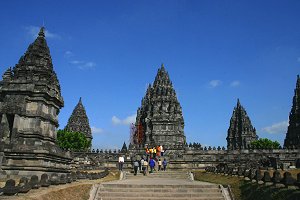
The ruins of Loro Jonggrang at Prambanan are the biggest Hindu ruins in Indonesia. Prambanan is the ninth century Hindu temple compound in Central Java, Indonesia, dedicated to Trimurti, the expression of God as the Creator (Brahma), the Sustainer (Vishnu) and the Destroyer (Shiva). The temple compound located approximately 18 km east of Yogyakarta city on the boundary between Yogyakarta and Central Java province.
The temple is a UNESCO World Heritage Site, currently is the largest Hindu temple in Indonesia, and is one of the largest Hindu temples in south-east Asia. It is characterised by its tall and pointed architecture, typical of Hindu temple architecture, and by the towering 47m high central building inside a large complex of individual temples.
Prambanan is the largest Hindu temple of ancient Java, and the construction of this royal temple was probably started by Rakai Pikatan as the Hindu Sanjayas answer to the BuddhistSailendra's Borobudur and Sewu temples nearby. The construction of Prambanan probably was meant to marked the return of Sanjaya dynasty to power after almost a century fell under Sailendra domination on Central Java.
A temple was first built at the site around 850 CE by either Rakai Pikatan or Balitung Maha Sambu the Sanjaya king of the Mataram Kingdom. According to Shivagrha inscription that wrotechandrasengkala ”Wwalung gunung sang wiku” (778 Saka/856 M), the temple was built to honor lord Shiva and the original name of the temple is Shiva-grha (the house of Shiva). Indeed, some archaeologists propose that the idol of Shiva in the garbhagriha (central chamber) of the main temple is modelled after King Balitung, serving as a depiction of his deified self after death.
The temple compound was expanded by successive Mataram kings such as Daksa and Tulodong with the addition hundreds of perwara temples around the chief temple. Prambanan served as the royal temple of the Hindu Kingdom of Mataram, with most of the state's religious ceremonies and sacrifices being conducted there. At the height of the Mataram kingdom, scholars estimate that hundreds of Brahmins with their disciples lived within the outer wall of the temple compound. The urban center and the court of Mataram were located nearby, somewhere in the Prambanan valley.
In the 930s, the court was shifted to East Java by Mpu Sindok, who established the Isyana Dynasty. While the reason for the shift remains uncertain, it was probably caused by an eruption of the volcano of Merapi located north of Prambanan, or a power struggle. That marked the beginning of the temple's decline. It was soon abandoned and began to deteriorate.
The temples themselves collapsed during a major earthquake in the 16th century. Although the temple ceased to be the important place of worship, the ruins scattered around the area itself still recognizable and known to local Javanese people in later period. The statues and the ruins become the theme and the inspirations for the Loro Jonggrang folktale. After the division of Mataram Sultanate in 1755, the temple ruins and Opak river mark the boundaries between Yogyakarta and Surakarta (Solo) Sultanates.
In 1811 during Britain’s short-lived rule of the Dutch East Indies, Collin Mackenzie, a surveyor in the service of Sir Thomas Stamford Raffles, came upon the temples by chance. Although Sir Thomas subsequently commissioned a full survey of the ruins, they remained neglected for decades, with Dutch residents carting off sculptures as garden ornaments and native villagers using the foundation stones for construction material.
Half-hearted excavations by archaeologists in the 1880s merely facilitated looting. Reconstruction of the compound began in 1918, and proper restoration only in 1930. Efforts at restoration continue to this day. The main building was completed around 1953. Since much of the original stonework has been stolen and reused at remote construction sites, hampering restoration and since a temple can be rebuilt only if at least 75% of the original masonry is available, only the foundations of most of the smaller shrines are now visible with no plans for their reconstruction.
Keraton Yogyakarta
Palace of the Sultan of Yogyakarta
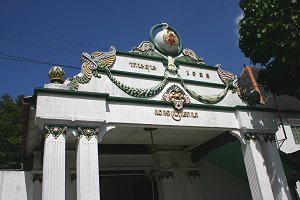 Keraton is the Javanese word for a royal palace
Keraton is the Javanese word for a royal palace. Its name is derived from ratu, which means "ruler" (king or queen). In Java, the palace of a prince is called puro or dalem. The general word to designate a palace is istana, as in Indonesian and Malay.
A calm yet elegant Javanese heritage that consists of two separate entrances: the Main Court (Pagilaran & Siti Hinggil), and the Residence. The Main Court showcases the grandeur of Sultan's monarchy, while the Residence is more homey while still exhibiting the royal family's luxurious lifestyle. Open 8.30 AM to 1 PM daily, on Friday the attraction is closed at 11 AM. While the guide is part of the entrance fee, they might expecting tips. Some guide might offer extended trip to sultan's servants batik workshop, this is a scam as they only bring you to a regular batik shop with steep price. It's a good idea to refuse their offer politely.
The Sultan's Square - Alun-alun utara, the northern Sultan's Grounds, was originally used for Sultan's army training and hence closed to public, but the area was opened to the public during the reign of Sri Sultan Hamengkubuwono IX. Now,alun-alun utara is the venue for the quarterly parade known as Garebeg, which is held in the month of Maulud, Besar and Sawal. In this parade, the Sultan's servants bring huge cone-shaped offerings to the alun-alun utara. After the parade, attendees scramble to get a scrap of this offering, as it is believed to bring good luck.
Prior to the month of Maulud, a public fair is held in alun-alun utara for 30 days. This fair is very popular and offers many kind of goods ranging from traditional handicrafts to melamine dishes from China. A unique snack sold in this event is galundeng, deep fried dough similar to a donut.
Sultan's Carriage Museum (Museum Kereta) - This museum houses Sultan's horse-drawn carriages, including two beautiful carriages imported from the Netherlands and known as Golden Carts (kereta kencana).
Taman Sari, Jalan Taman, Kraton Yogyakarta 55133 - Also known by the Dutch name waterkasteel(water castle), this is a partly ruined complex built as a pleasure garden by the first Sultan in 1765. One of the bathing pools was dedicated to the sultan's harem, and he had a tower overlooking the area so he could take his pick.
Siti Hinggil Selatan - This somehow-muted palace is rarely used for formal occasion. You can catch a shadow puppet performance during weekend night.
Alun-Alun or the Sultan's ground - There are two Sultan's grounds: Alun-alun Utara and Alun-alun Selatan or the northern and southern Sultan's ground, consecutively. If you are lucky, you can see the Gerebeg Maulud parade during Prophet Muhammad's birthday.
Masjid Gede Kauman - one of the oldest and largest mosque in Yogyakarta. Located on the west of Alun-alun Utara, this mosque was where the Sultan performs his religious rites and ceremonies. Non-muslim visitors should wear decent clothing. It may be a good idea to ask the mosque authorities prior to entering the mosque due to some rules that must be abide.
Kalasan Temple
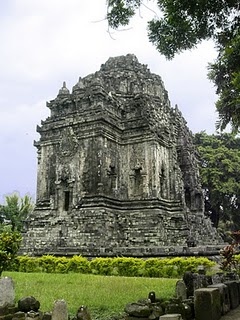
Kalasan Temple (also known as Candi Kalasan or candi Kalibening) is an 8th century Buddhist temple located 13 km east of the Yogyakarta on the way to Prambanan temple, right on south side of main road 'Jalan Solo' between Yogyakarta and Surakarta, Indonesia.
The temple stands on square 14.20 meters sub-basement. The temple plan is cross-shaped 12 corners polygon. Each of four cardinal points have stairs and gates adorned with Kala-Makara and also have rooms measured 3,5 square meters. No statue is found in the smaller room facing north, west, and south; but the lotus pedestals suggested that the rooms once contains statues of bodhisattvas. The temple is richly decorated with buddhist figures such as bodhisattva and gana. The Kala Face above the southern door has been photographed and used by a number of foreign academics in their books to give an idea of the artistry in stone by Central Javanese artists of a millennia ago. Niches where the statues would have been placed are found inside and outside the temple. The niches adorned outer wall intricately carved with Kala, gods and divinities in scene of svargaloka, celestial palace abode of gods, apsaras, and gandharvas.
The roof of the temple is designed in three sections. The lower one are still according to the polygonal shape of the body and contains small niches with statues of boddhisatvas seated on lotus. Each of this niches is crowned with stupas. The middle part of the roof is inoctagonal (eight sided) shape. Each of this eight sides adorned with niches contains statue of a Dhyani Buddha flanked by two standing boddhisatvas. The top part of the roof is almost circular and also have 8 niches crowned with single large dagoba. The octagonal aspect of the structure has led to speculation of non-buddhist elements in the temple, similar to some interpretations of the early Borobudur structure.
The temple is facing east, with eastern room also served as access to main central room. In the larger main room there is lotus pedestal and throne carved with makara, lion, and elephant figure, similar to the Budha Vairocana throne founds in Mendut temple. According to the Kalasan inscription, the temple once houses the large (probably reaching 4 meters tall) statue of the Boddhisattvadevi Tara. By the design of the throne, most probably the statue of the goddess was in seated position and made from bronze. Now the statue is missing, probably the same fate as bronze Buddha statue in Sewu temple, being looted for scrap metal over centuries. On the outer wall of the temple found the traces of plaster called vajralepa (lit: diamond plaster). The same substance also founds in nearby Saritemple. The white-yellowish plaster was applied to protect the temple wall, but now the plaster has worn off.
The temple is located on archaeologically rich Prambanan valley. Just a few hundred meters north east from Kalasan temple is located Sari temple. Candi Sari most probably was the monastery mentioned in Kalasan inscription. Further east lies the Prambanan complex, Sewu temple, and Plaosan temple.
Imogiri Royal Cemetery
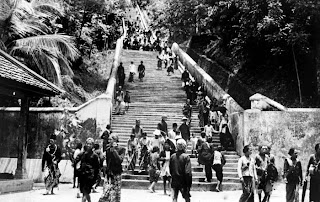
Imogiri (also Imagiri) is a royal graveyard complex in Yogyakarta, in south-central Java, Indonesia, as well as a modern village located near the graveyard in Bantul regency. Imogiri is a traditional resting place for the royalty of central Java, including many rulers of the Sultanate of Mataram and of the current houses of Surakarta and Yogyakarta Sultanate. The name Imagiri is derived from Sanskrit Himagiri, which means 'mountain of snow'. The latter is another name for Himalaya. The Royal Graveyard that preceded was Kota Gede. The graveyard was constructed by Sultan Agung of Mataram in the later years of his reign, probably in the 1640s. The graveyard is a significant pilgrimage ziarah site, particularly on significant dates in the Javanese calendar (such as Satu Suro, New Year's Day), and the Islamic calendar.
It also belongs to a larger network of significant locations in Javanese pilgrimage traditions. It is possibly the only major location remaining in Java where the Palaces of Surakarta and Yogyakarta have personnel manning a jointly administered royal graveyard.
Among the site's most prominent graves are that of early Mataram ruler Sultan Agung of Mataram, and Sultan of Yogyakarta Hamengkubuwono IX, a leader during Indonesia's war for independence. The most recent is that of Pakubuwana XII of Surakarta who was buried in 2004.
The Imogiri complex is separated into three parts, named Giriloyo, Banyusumurup and Imogiri. Traditionally it is accepted that Giriloyo was the earliest of the three graveyards. In some local folklore, Sultan Agung had commenced work on his own graveyard at Giriloyo - but because his uncle Juminah died at the graveyard, Agung was guided by various portents to choose his graveyard on a hill some three kilometres to the southwest, at Imogiri. A later ruler, needing to bury outcasts in a graveyard separate from Giriloyo and Imogiri, chose Banyusumurup as an appropriate site. However it is possible to find rivals and enemies within Javanese royal families buried within metres of each other inside the walls of Imogiri.
Many travel accounts, tourist guides and references to Imogiri imply a simple single whole. On closer examination the graveyard has more complexity within its structure. The complex is divided in two ways. First, there are separate Yogyakartan and Surakartan sections. Second, the whole graveyard is divided into eight sections which constitute three generations of ruler in each section. Some are jointly governed by custodians (Juru Kunci) from Surakarta and Yogyakarta, while some are governed by representatives of one of these palaces only. The original area within the Imogiri graveyard is that area with Sultan Agung's grave - it is jointly governed. The western wing of the graveyard is the Surakartan section, while the eastern wing is the Yogyakartan section.
Not all rulers of the Sultanate of Mataram are buried in the Imogiri complex; there are a number of rulers who are buried elsewhere in Java. Some immediate families of rulers were also buried in Imogiri, but not all; this was dependent upon each ruler's preferences. Printed lists of the burial plots within the royal graveyard complex are maintained for Imogiri to provide guidance for researchers looking for a specific grave site. This process is sometimes complicated by the multiple names some individuals were known by during their lives.
Parangtritis Beach
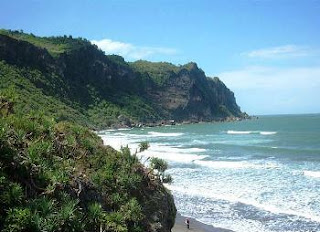
Parangtritis Beach is situated in Parangtritis Village about 17 km to the South of Bantul City. It is a plain beach, with rocky hill view in the eastern and northern part, and also sand along the beach and barchans type of sand dunes in the western part. In this beach visitors can go around using carts or horses, which are for rental and driven by the local people. Beside being famous for its beauty, Parangtritis Beach is also a sacred place.
Dirgantara Mandala Museum
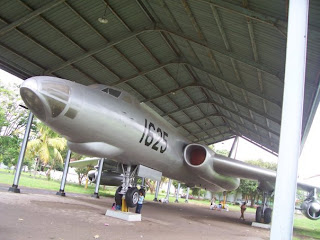
The museum keeps pictures and models of aeroplanes. Some are models of aeroplanes left by Japanese army (which then were used by the Indonesian air-force), the other models are fighting, transportation, and exercise aeroplanes. Please note that visitors have to inform the officer in charge at least one day in advance to visit the museum. The museum is located in the Lanuma Adisucipto complex.
Cerme Cave Walisongo

The 1200 m long cave was used as a meeting place for teaching Islam in Java. Beside the main cave with a beautiful collection of stalactites and stalagmites you will find some smaller caves. The complex is located in Srunggo, Selopamioro, 22 km from Yogyakarta in the Bantul Regency.
Batik Research Centre

Situated on the eastern outskirts of the city, it has an interesting permanent exhibition of batiks in classic and modern designs The process of batik can also be seen here, both the hand drawn and hand stamped.
Dewantara Kirti Griya

The former home of Ki Hajar Dewantoro (founder of the Taman Siswa Institute, the oldest national education institute), was established in 1932. He was both an educator and a fervent patriot fighting for independence, and a close friend of Rabindranath Tagore (an educational figure from India). The building style, carving, reliefs and the very attractive statues bring the image of harmony and dynamism of Indonesian cultural artwork.
Malioboro Street
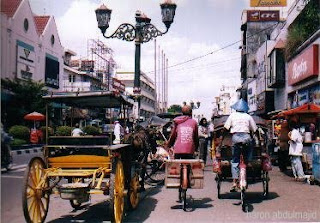
Despite the growing appeal of the new shopping street Jalan Urip Sumoharjo, with its up dated commercial trapping, the vibrant life of the city is still centered along Malioboro and Ahmad Yani street, extending from the railway to the public square facing the Sultan's Palace. The shops open from 9am to 2pm and 6pm to 9pm including Sundays. There are dozens of cozy restaurants with reasonable prices and serving wide selections of dishes.
Kota Gede
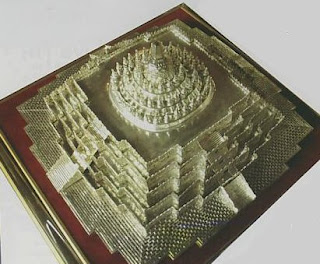
If you are interested in exploring the local silver craft production, it is worth visiting Kota Gede, about 6 km south of Yogyakarta. There are two kinds of silver craft produced: white and black silver. The best is to walk around Kota Gede and visit so as many shops as possible to assess the best place to buy your favoured pieces at reasonable prices.
Kasongan
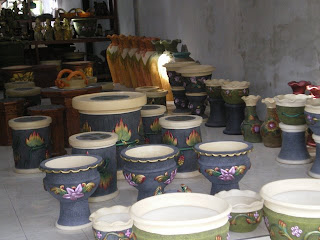
A village 7 km to the south of Yogyakarta, is the number one location for pottery craft as well as earthenware and ceramics. Due the influence of long staying foreigners, the pottery industry these days offers a broad spectrum of pottery items and ceramics, from giant vases to little funny souvenirs.
Yogyakarta Shopping

Shopping in Yogyakarta is like shopping no where else on earth. Here you will find treasures to take home with you that will please you for years to come. Traditional Indonesian arts and crafts are popular as souvenirs. Batik, the oldest traditional Javanese art is done as hand painted or hand-woven fabric. Their usefulness is endless, from a simple beach-wrap, to a baby hammock or future wall hanging or cushion cover. Due the important role of batik painting in the daily life of the people in Central Java, Yogyakarta has plenty of Batik Schools and Colleges. NOTE: These offer batik painting courses for foreigners. Woodcarvings and paintings are easily available. In the smaller shops, bargaining is accepted; however, in larger shops, prices are fixed. The Yogyakarta leather craft industry traditionally uses the hide of water buffaloes, cows and goats. The most famous leather craft product is the Wayang Kulit, the puppet used for the well known Javanese Shadow Play. Beside this, leather is the basic material for producing room decorations, bags, sandals, and souvenirs. Electronics goods are both high quality and inexpensive with all major brands available. Signature 'Prestige' fashion goods are available at very competitive prices.
Many more tourist sites in Yogyakarta is not mentioned, as a guide about Yogyakarta, you can see the website
theincrediblejava.com.
COME ON TO VISIT:
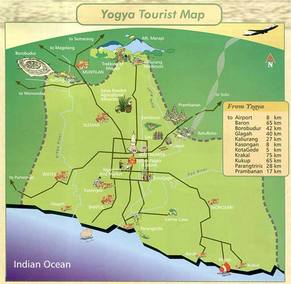

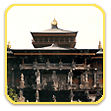

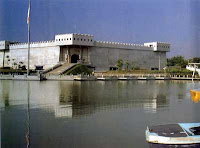
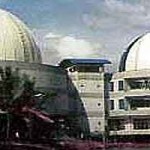
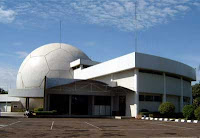





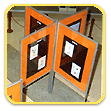
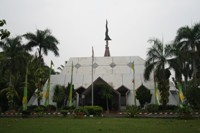

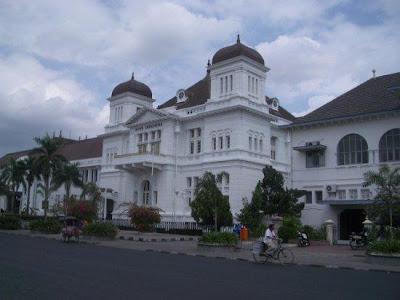
 In Indonesian, ancient temples are known as candi; thus "Borobudur Temple" is locally known as Candi Borobudur. The term candi is also used more loosely to describe any ancient structure, for example gates and bathing structures. The origins of the name Borobudur however are unclear, although the original names of most ancient Indonesian temples are no longer known. The name Borobudur was first written in Sir Thomas Raffles' book on Javan history. Raffles wrote about a monument called borobudur, but there are no older documents suggesting the same name. The only old Javanese manuscript that hints at the monument as a holy Buddhist sanctuary is Nagarakretagama, written by Mpu Prapanca in 1365. The name 'Bore-Budur', and thus 'BoroBudur', is thought to have been written by Raffles in English grammar to mean the nearby village of Bore; most candi are named after a nearby village. If it followed Javanese language, the monument should have been named 'BudurBoro'. Raffles also suggested that 'Budur' might correspond to the modern Javanese word Buda ('ancient') – i.e., 'ancient Boro'. However, another archaeologist suggests the second component of the name ('Budur') comes from Javanese term bhudhara (mountain).
In Indonesian, ancient temples are known as candi; thus "Borobudur Temple" is locally known as Candi Borobudur. The term candi is also used more loosely to describe any ancient structure, for example gates and bathing structures. The origins of the name Borobudur however are unclear, although the original names of most ancient Indonesian temples are no longer known. The name Borobudur was first written in Sir Thomas Raffles' book on Javan history. Raffles wrote about a monument called borobudur, but there are no older documents suggesting the same name. The only old Javanese manuscript that hints at the monument as a holy Buddhist sanctuary is Nagarakretagama, written by Mpu Prapanca in 1365. The name 'Bore-Budur', and thus 'BoroBudur', is thought to have been written by Raffles in English grammar to mean the nearby village of Bore; most candi are named after a nearby village. If it followed Javanese language, the monument should have been named 'BudurBoro'. Raffles also suggested that 'Budur' might correspond to the modern Javanese word Buda ('ancient') – i.e., 'ancient Boro'. However, another archaeologist suggests the second component of the name ('Budur') comes from Javanese term bhudhara (mountain). Mendut is a ninth century Buddhist temple, located in Mendut village, Mungkid sub-district, Magelang Regency, Central Java,Indonesia. The temple located about three kilometres east from Borobudur. Mendut, Borobudur and Pawon, all of which are Buddhist temples, are located in one straight line. There is a mutual religious relationship between the three temples, although the exact ritual process is unknown.
Mendut is a ninth century Buddhist temple, located in Mendut village, Mungkid sub-district, Magelang Regency, Central Java,Indonesia. The temple located about three kilometres east from Borobudur. Mendut, Borobudur and Pawon, all of which are Buddhist temples, are located in one straight line. There is a mutual religious relationship between the three temples, although the exact ritual process is unknown. The ruins of Loro Jonggrang at Prambanan are the biggest Hindu ruins in Indonesia. Prambanan is the ninth century Hindu temple compound in Central Java, Indonesia, dedicated to Trimurti, the expression of God as the Creator (Brahma), the Sustainer (Vishnu) and the Destroyer (Shiva). The temple compound located approximately 18 km east of Yogyakarta city on the boundary between Yogyakarta and Central Java province.
The ruins of Loro Jonggrang at Prambanan are the biggest Hindu ruins in Indonesia. Prambanan is the ninth century Hindu temple compound in Central Java, Indonesia, dedicated to Trimurti, the expression of God as the Creator (Brahma), the Sustainer (Vishnu) and the Destroyer (Shiva). The temple compound located approximately 18 km east of Yogyakarta city on the boundary between Yogyakarta and Central Java province. Keraton is the Javanese word for a royal palace. Its name is derived from ratu, which means "ruler" (king or queen). In Java, the palace of a prince is called puro or dalem. The general word to designate a palace is istana, as in Indonesian and Malay.
Keraton is the Javanese word for a royal palace. Its name is derived from ratu, which means "ruler" (king or queen). In Java, the palace of a prince is called puro or dalem. The general word to designate a palace is istana, as in Indonesian and Malay. Kalasan Temple (also known as Candi Kalasan or candi Kalibening) is an 8th century Buddhist temple located 13 km east of the Yogyakarta on the way to Prambanan temple, right on south side of main road 'Jalan Solo' between Yogyakarta and Surakarta, Indonesia.
Kalasan Temple (also known as Candi Kalasan or candi Kalibening) is an 8th century Buddhist temple located 13 km east of the Yogyakarta on the way to Prambanan temple, right on south side of main road 'Jalan Solo' between Yogyakarta and Surakarta, Indonesia. Imogiri (also Imagiri) is a royal graveyard complex in Yogyakarta, in south-central Java, Indonesia, as well as a modern village located near the graveyard in Bantul regency. Imogiri is a traditional resting place for the royalty of central Java, including many rulers of the Sultanate of Mataram and of the current houses of Surakarta and Yogyakarta Sultanate. The name Imagiri is derived from Sanskrit Himagiri, which means 'mountain of snow'. The latter is another name for Himalaya. The Royal Graveyard that preceded was Kota Gede. The graveyard was constructed by Sultan Agung of Mataram in the later years of his reign, probably in the 1640s. The graveyard is a significant pilgrimage ziarah site, particularly on significant dates in the Javanese calendar (such as Satu Suro, New Year's Day), and the Islamic calendar.
Imogiri (also Imagiri) is a royal graveyard complex in Yogyakarta, in south-central Java, Indonesia, as well as a modern village located near the graveyard in Bantul regency. Imogiri is a traditional resting place for the royalty of central Java, including many rulers of the Sultanate of Mataram and of the current houses of Surakarta and Yogyakarta Sultanate. The name Imagiri is derived from Sanskrit Himagiri, which means 'mountain of snow'. The latter is another name for Himalaya. The Royal Graveyard that preceded was Kota Gede. The graveyard was constructed by Sultan Agung of Mataram in the later years of his reign, probably in the 1640s. The graveyard is a significant pilgrimage ziarah site, particularly on significant dates in the Javanese calendar (such as Satu Suro, New Year's Day), and the Islamic calendar. Parangtritis Beach is situated in Parangtritis Village about 17 km to the South of Bantul City. It is a plain beach, with rocky hill view in the eastern and northern part, and also sand along the beach and barchans type of sand dunes in the western part. In this beach visitors can go around using carts or horses, which are for rental and driven by the local people. Beside being famous for its beauty, Parangtritis Beach is also a sacred place.
Parangtritis Beach is situated in Parangtritis Village about 17 km to the South of Bantul City. It is a plain beach, with rocky hill view in the eastern and northern part, and also sand along the beach and barchans type of sand dunes in the western part. In this beach visitors can go around using carts or horses, which are for rental and driven by the local people. Beside being famous for its beauty, Parangtritis Beach is also a sacred place. The museum keeps pictures and models of aeroplanes. Some are models of aeroplanes left by Japanese army (which then were used by the Indonesian air-force), the other models are fighting, transportation, and exercise aeroplanes. Please note that visitors have to inform the officer in charge at least one day in advance to visit the museum. The museum is located in the Lanuma Adisucipto complex.
The museum keeps pictures and models of aeroplanes. Some are models of aeroplanes left by Japanese army (which then were used by the Indonesian air-force), the other models are fighting, transportation, and exercise aeroplanes. Please note that visitors have to inform the officer in charge at least one day in advance to visit the museum. The museum is located in the Lanuma Adisucipto complex. The 1200 m long cave was used as a meeting place for teaching Islam in Java. Beside the main cave with a beautiful collection of stalactites and stalagmites you will find some smaller caves. The complex is located in Srunggo, Selopamioro, 22 km from Yogyakarta in the Bantul Regency.
The 1200 m long cave was used as a meeting place for teaching Islam in Java. Beside the main cave with a beautiful collection of stalactites and stalagmites you will find some smaller caves. The complex is located in Srunggo, Selopamioro, 22 km from Yogyakarta in the Bantul Regency. Situated on the eastern outskirts of the city, it has an interesting permanent exhibition of batiks in classic and modern designs The process of batik can also be seen here, both the hand drawn and hand stamped.
Situated on the eastern outskirts of the city, it has an interesting permanent exhibition of batiks in classic and modern designs The process of batik can also be seen here, both the hand drawn and hand stamped. The former home of Ki Hajar Dewantoro (founder of the Taman Siswa Institute, the oldest national education institute), was established in 1932. He was both an educator and a fervent patriot fighting for independence, and a close friend of Rabindranath Tagore (an educational figure from India). The building style, carving, reliefs and the very attractive statues bring the image of harmony and dynamism of Indonesian cultural artwork.
The former home of Ki Hajar Dewantoro (founder of the Taman Siswa Institute, the oldest national education institute), was established in 1932. He was both an educator and a fervent patriot fighting for independence, and a close friend of Rabindranath Tagore (an educational figure from India). The building style, carving, reliefs and the very attractive statues bring the image of harmony and dynamism of Indonesian cultural artwork. Despite the growing appeal of the new shopping street Jalan Urip Sumoharjo, with its up dated commercial trapping, the vibrant life of the city is still centered along Malioboro and Ahmad Yani street, extending from the railway to the public square facing the Sultan's Palace. The shops open from 9am to 2pm and 6pm to 9pm including Sundays. There are dozens of cozy restaurants with reasonable prices and serving wide selections of dishes.
Despite the growing appeal of the new shopping street Jalan Urip Sumoharjo, with its up dated commercial trapping, the vibrant life of the city is still centered along Malioboro and Ahmad Yani street, extending from the railway to the public square facing the Sultan's Palace. The shops open from 9am to 2pm and 6pm to 9pm including Sundays. There are dozens of cozy restaurants with reasonable prices and serving wide selections of dishes. If you are interested in exploring the local silver craft production, it is worth visiting Kota Gede, about 6 km south of Yogyakarta. There are two kinds of silver craft produced: white and black silver. The best is to walk around Kota Gede and visit so as many shops as possible to assess the best place to buy your favoured pieces at reasonable prices.
If you are interested in exploring the local silver craft production, it is worth visiting Kota Gede, about 6 km south of Yogyakarta. There are two kinds of silver craft produced: white and black silver. The best is to walk around Kota Gede and visit so as many shops as possible to assess the best place to buy your favoured pieces at reasonable prices. A village 7 km to the south of Yogyakarta, is the number one location for pottery craft as well as earthenware and ceramics. Due the influence of long staying foreigners, the pottery industry these days offers a broad spectrum of pottery items and ceramics, from giant vases to little funny souvenirs.
A village 7 km to the south of Yogyakarta, is the number one location for pottery craft as well as earthenware and ceramics. Due the influence of long staying foreigners, the pottery industry these days offers a broad spectrum of pottery items and ceramics, from giant vases to little funny souvenirs. Shopping in Yogyakarta is like shopping no where else on earth. Here you will find treasures to take home with you that will please you for years to come. Traditional Indonesian arts and crafts are popular as souvenirs. Batik, the oldest traditional Javanese art is done as hand painted or hand-woven fabric. Their usefulness is endless, from a simple beach-wrap, to a baby hammock or future wall hanging or cushion cover. Due the important role of batik painting in the daily life of the people in Central Java, Yogyakarta has plenty of Batik Schools and Colleges. NOTE: These offer batik painting courses for foreigners. Woodcarvings and paintings are easily available. In the smaller shops, bargaining is accepted; however, in larger shops, prices are fixed. The Yogyakarta leather craft industry traditionally uses the hide of water buffaloes, cows and goats. The most famous leather craft product is the Wayang Kulit, the puppet used for the well known Javanese Shadow Play. Beside this, leather is the basic material for producing room decorations, bags, sandals, and souvenirs. Electronics goods are both high quality and inexpensive with all major brands available. Signature 'Prestige' fashion goods are available at very competitive prices.
Shopping in Yogyakarta is like shopping no where else on earth. Here you will find treasures to take home with you that will please you for years to come. Traditional Indonesian arts and crafts are popular as souvenirs. Batik, the oldest traditional Javanese art is done as hand painted or hand-woven fabric. Their usefulness is endless, from a simple beach-wrap, to a baby hammock or future wall hanging or cushion cover. Due the important role of batik painting in the daily life of the people in Central Java, Yogyakarta has plenty of Batik Schools and Colleges. NOTE: These offer batik painting courses for foreigners. Woodcarvings and paintings are easily available. In the smaller shops, bargaining is accepted; however, in larger shops, prices are fixed. The Yogyakarta leather craft industry traditionally uses the hide of water buffaloes, cows and goats. The most famous leather craft product is the Wayang Kulit, the puppet used for the well known Javanese Shadow Play. Beside this, leather is the basic material for producing room decorations, bags, sandals, and souvenirs. Electronics goods are both high quality and inexpensive with all major brands available. Signature 'Prestige' fashion goods are available at very competitive prices.
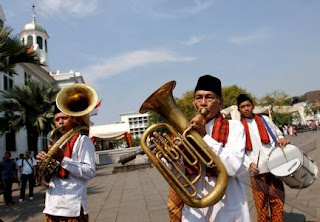 The Betawi (Orang Betawi, or "people of Batavia") is a term used to describe the descendants of the people living in and around Batavia and recognized as an ethnic group from around the 18th-19th century.The Betawi people are mostly descended from various Southeast Asian ethnic groups brought or attracted to Batavia to meet labor needs, and include people from different parts of Indonesia. The language and Betawi culture are distinct from those of the Sundanese or Javanese. The language is mostly based on the East Malay dialect and enriched by loan words from Sundanese, Javanese, Chinese, and Arabic. Nowadays, the Jakarta dialect Bahasa Jakarta) used as a street language by people in Jakarta is loosely based on the Betawi language.
The Betawi (Orang Betawi, or "people of Batavia") is a term used to describe the descendants of the people living in and around Batavia and recognized as an ethnic group from around the 18th-19th century.The Betawi people are mostly descended from various Southeast Asian ethnic groups brought or attracted to Batavia to meet labor needs, and include people from different parts of Indonesia. The language and Betawi culture are distinct from those of the Sundanese or Javanese. The language is mostly based on the East Malay dialect and enriched by loan words from Sundanese, Javanese, Chinese, and Arabic. Nowadays, the Jakarta dialect Bahasa Jakarta) used as a street language by people in Jakarta is loosely based on the Betawi language. Betawi arts are rarely found in Jakarta due to their infamous low-profile and most Betawi have moved to the border of Jakarta, displaced by new immigrants. It is easier to find Java or Minang based wedding ceremonial instead of Betawi weddings in Jakarta. It is easier to find Javanese Gamelan instead of Gambang Kromong (a mixture between Betawi and Chinese music) or Tanjidor (a mixture between Betawi and Portuguese music) or Marawis (a mixture between Betawi and Yaman music). However, some festivals such as the Jalan Jaksa Festival or Kemang Festival include efforts to preserve Betawi arts by inviting artists to give performances.
Betawi arts are rarely found in Jakarta due to their infamous low-profile and most Betawi have moved to the border of Jakarta, displaced by new immigrants. It is easier to find Java or Minang based wedding ceremonial instead of Betawi weddings in Jakarta. It is easier to find Javanese Gamelan instead of Gambang Kromong (a mixture between Betawi and Chinese music) or Tanjidor (a mixture between Betawi and Portuguese music) or Marawis (a mixture between Betawi and Yaman music). However, some festivals such as the Jalan Jaksa Festival or Kemang Festival include efforts to preserve Betawi arts by inviting artists to give performances. This place is miniature of Indonesia, illustrated the diversity of cultures, customs and traditions in Indonesia. Here also there is Museum, please visit
This place is miniature of Indonesia, illustrated the diversity of cultures, customs and traditions in Indonesia. Here also there is Museum, please visit 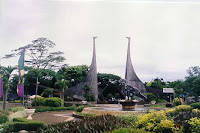 Ragunan zoo is a kind of combination between zoo and park. It has almost 30,000 plants from 250 different kinds of. Since it is a combination between zoo and park, Ragunan Zoo is also known as Ragunan Zoological Park.
Ragunan zoo is a kind of combination between zoo and park. It has almost 30,000 plants from 250 different kinds of. Since it is a combination between zoo and park, Ragunan Zoo is also known as Ragunan Zoological Park. Indonesia National Monument or what Indonesian and Jakarta people usually call as Monas is a monument built to remember the struggle of Indonesian heroes fighting the colonial domination.
Indonesia National Monument or what Indonesian and Jakarta people usually call as Monas is a monument built to remember the struggle of Indonesian heroes fighting the colonial domination.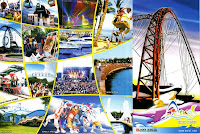 Jaya Ancol Dreamland Park is a recreation area located at the seashore of Jakarta Gulf. Jaya Ancol Dreamland Park is better known as Ancol by most of Indonesian people. There’re several recreation facilities you can find at Jaya Ancol Dreamland Park: Golf Course, Ancol Marina Bay, Art Market (Pasar Seni), Dunia Fantasy, SeaWorld Indonesia, Gelanggang Samudera, Atlantis Water Adventure, andBeach Park (Taman Pantai). Jaya Ancol Dreamland Park provides facilities for those visitors who wants to stay in the Ancol area. Visitors can choose between three hotels and one cottage provided which respectively are Raddin Hotel, Mercure Hotel, Wisata Hotel and Putri Duyung Cottage.
Jaya Ancol Dreamland Park is a recreation area located at the seashore of Jakarta Gulf. Jaya Ancol Dreamland Park is better known as Ancol by most of Indonesian people. There’re several recreation facilities you can find at Jaya Ancol Dreamland Park: Golf Course, Ancol Marina Bay, Art Market (Pasar Seni), Dunia Fantasy, SeaWorld Indonesia, Gelanggang Samudera, Atlantis Water Adventure, andBeach Park (Taman Pantai). Jaya Ancol Dreamland Park provides facilities for those visitors who wants to stay in the Ancol area. Visitors can choose between three hotels and one cottage provided which respectively are Raddin Hotel, Mercure Hotel, Wisata Hotel and Putri Duyung Cottage. The National Museum of Indonesia (Indonesian: Museum Nasional), is an archeological, historical, ethnological, and geographicalmuseum located in Jakarta. Popularly known as Elephant Building (Indonesian: Gedung Gajah) after the elephant statue in its forecourt. Its broad and fascinating collections covers all of Indonesia's territory and almost all of its history. The museum has endeavoured to preserve Indonesia's heritage for two centuries.
The National Museum of Indonesia (Indonesian: Museum Nasional), is an archeological, historical, ethnological, and geographicalmuseum located in Jakarta. Popularly known as Elephant Building (Indonesian: Gedung Gajah) after the elephant statue in its forecourt. Its broad and fascinating collections covers all of Indonesia's territory and almost all of its history. The museum has endeavoured to preserve Indonesia's heritage for two centuries. Kota Tua, Jakarta is an area of Dutch colonization inheritance which was well-known as Batavia in the 17th century. At Kota Tua area you can see old buildings with architecture style influenced by the Dutch or European architecture style, Chinese and even some of them with combination of Dutch and Chinese architecture. Some of the old buildings at Kota Tua area occupied as museums by the governor of DKI Jakarta. Kota Tua is one of a very interesting place or area to visit when you travel toJakarta since it’s a center of historical tourism object in Jakarta.
Kota Tua, Jakarta is an area of Dutch colonization inheritance which was well-known as Batavia in the 17th century. At Kota Tua area you can see old buildings with architecture style influenced by the Dutch or European architecture style, Chinese and even some of them with combination of Dutch and Chinese architecture. Some of the old buildings at Kota Tua area occupied as museums by the governor of DKI Jakarta. Kota Tua is one of a very interesting place or area to visit when you travel toJakarta since it’s a center of historical tourism object in Jakarta. Jakarta History Museum is known as Fatahillah Museum. Jakarta History Museum provides information on Jakarta’s history, starting from the prehistoric age to current age, in a creative way, through the collections of the museum.
Jakarta History Museum is known as Fatahillah Museum. Jakarta History Museum provides information on Jakarta’s history, starting from the prehistoric age to current age, in a creative way, through the collections of the museum. Along Sunda Kelapa Harbor you could see Phinisi ships in a line, which have unique shape and the body painted in some different colors. Phinisi ships were coming from many regions of Indonesia, carrying logs, rattan, copra and other agricultural products to Jakarta. When Phinisi goes back fromJakarta, it carries construction materials like steel and cement. You could see the hectic of loading and unloading activities that is still conducted traditionally at Sunda Kelapa.
Along Sunda Kelapa Harbor you could see Phinisi ships in a line, which have unique shape and the body painted in some different colors. Phinisi ships were coming from many regions of Indonesia, carrying logs, rattan, copra and other agricultural products to Jakarta. When Phinisi goes back fromJakarta, it carries construction materials like steel and cement. You could see the hectic of loading and unloading activities that is still conducted traditionally at Sunda Kelapa.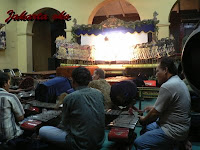 Wayang is a theatrical performance employing puppets or human dancer. The puppet could be made of leather which perform shadow puppets play, or of wooden. Wayang Museum (used to be called as Shadow Puppet Museum as well) is a museum which keeps collections of wayang from various territories in Indonesia and even from other countries. The idea of building Wayang Museum started when H. Ali Sadikin, the governor of DKI Jakarta, attended the second wayang museum week in 1974. With the support of the committee of the wayang museum week, wayang lovers, and the governor of DKI Jakarta, then the building at Jalan Pintu Besar Utara # 27, West Jakarta decided to be Wayang Museum. The museum was officially open on 13th August, 1975 by the governor of DKI Jakarta, H. Ali Sadikin.
Wayang is a theatrical performance employing puppets or human dancer. The puppet could be made of leather which perform shadow puppets play, or of wooden. Wayang Museum (used to be called as Shadow Puppet Museum as well) is a museum which keeps collections of wayang from various territories in Indonesia and even from other countries. The idea of building Wayang Museum started when H. Ali Sadikin, the governor of DKI Jakarta, attended the second wayang museum week in 1974. With the support of the committee of the wayang museum week, wayang lovers, and the governor of DKI Jakarta, then the building at Jalan Pintu Besar Utara # 27, West Jakarta decided to be Wayang Museum. The museum was officially open on 13th August, 1975 by the governor of DKI Jakarta, H. Ali Sadikin.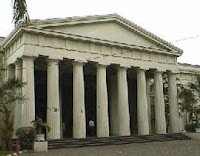 Fine Art and Ceramic Museum presents collections of ndonesian artist works of art from the era of 1800 to the current era. Fine Art and Ceramic Museum occupies a building, named Fine Art Hall. Before it’s occupied as a museum, the hall had been occupied by many organizations and instances from the time of Holland collonialization to the after independence time.
Fine Art and Ceramic Museum presents collections of ndonesian artist works of art from the era of 1800 to the current era. Fine Art and Ceramic Museum occupies a building, named Fine Art Hall. Before it’s occupied as a museum, the hall had been occupied by many organizations and instances from the time of Holland collonialization to the after independence time. Thousand Island lies in the waters of Jakarta Bay which has 100 miles length and 108,000 ha width. There’re about 110 islands, in some large and small group of islands in the Thousand Island. Those islands divided into tourism islands, conservation, historical island, and island for community empowerment in accordance with the characteristics differences between each island.
Thousand Island lies in the waters of Jakarta Bay which has 100 miles length and 108,000 ha width. There’re about 110 islands, in some large and small group of islands in the Thousand Island. Those islands divided into tourism islands, conservation, historical island, and island for community empowerment in accordance with the characteristics differences between each island.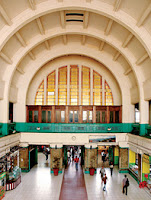 Jakarta Kota Station (also called BEOS by local people) is railway station of the Dutch inheritance. Jakarta Kota Station (BEOS) is located at the area of Kota Tua, Jakarta, and that’s why the name became Jakarta Kota Station. In the Dutch governmental time, Kota Tua Jakarta was well-known as Batavia. At that time Jakarta Kota Station (BEOS) was utilized to connect Batavia City with other areas near to Batavia, such as Bogor and Bandung.
Jakarta Kota Station (also called BEOS by local people) is railway station of the Dutch inheritance. Jakarta Kota Station (BEOS) is located at the area of Kota Tua, Jakarta, and that’s why the name became Jakarta Kota Station. In the Dutch governmental time, Kota Tua Jakarta was well-known as Batavia. At that time Jakarta Kota Station (BEOS) was utilized to connect Batavia City with other areas near to Batavia, such as Bogor and Bandung.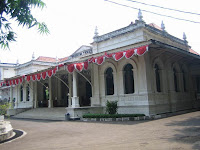 Textile Museum has thousands collections of traditional textiles with various motif and ornaments from each territories in Indonesia. Textile Museum occupies a very artistic and luxurious building. Inside the building there are display rooms used to display Indonesian textiles, including collections of the museum, designer and textile lover’s society. At the back side of the museum’s main building there is natural dye park which functioned to conserve and introduce the plants can be used as natural coloring material to the textile lovers. Even currently the natural dye has been replaced by synthetic color, however the shift in the use of material and tools not reducing the beauty of Indonesian textile.
Textile Museum has thousands collections of traditional textiles with various motif and ornaments from each territories in Indonesia. Textile Museum occupies a very artistic and luxurious building. Inside the building there are display rooms used to display Indonesian textiles, including collections of the museum, designer and textile lover’s society. At the back side of the museum’s main building there is natural dye park which functioned to conserve and introduce the plants can be used as natural coloring material to the textile lovers. Even currently the natural dye has been replaced by synthetic color, however the shift in the use of material and tools not reducing the beauty of Indonesian textile.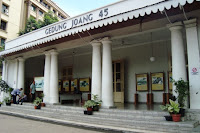 Battle’45 Museum (Museum Joang’45) collects inheritances from the Indonesian independence battle time, that used/worn by Indonesian warriors. Visiting Battle’45 Museum would increase your knowledge and insight about Indonesian journey from the colonization time until finally free and independent.
Battle’45 Museum (Museum Joang’45) collects inheritances from the Indonesian independence battle time, that used/worn by Indonesian warriors. Visiting Battle’45 Museum would increase your knowledge and insight about Indonesian journey from the colonization time until finally free and independent. Maritime Museum presents complete information about Indonesian nautical matters. Maritime Museum occupied two levels of building used as exhibition rooms from the total of three levels of floor in the building. Thes material used on the building dominated by wood. Large windows in the building functioned as ventilation, making the building has a good air circulation.
Maritime Museum presents complete information about Indonesian nautical matters. Maritime Museum occupied two levels of building used as exhibition rooms from the total of three levels of floor in the building. Thes material used on the building dominated by wood. Large windows in the building functioned as ventilation, making the building has a good air circulation.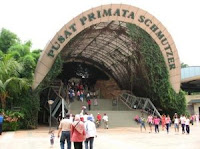 Schmutzer Primate Center is an artificial habitat of primates like gorilla, chimpanzee, orang utan and other kinds of primate. Schmutzer Primate Center is located at Ragunan Zoological Park area. Visitors of Schmutzer Primate Center can observe the behavior and activities of gorilla from a sky cross that was built over the area where gorillas inhabited. The sky cross for observation that’s covered by canopy roof is the main lane that visitors would find once they enter the building. The design of Schmutzer Primate Center was set close to the natural primate habitat with attractive layout of each room. The layout of Schmutzer accommodates the pleasure of primates as inhabitant and visitors who want to see the natural life of primates as in the wild nature.
Schmutzer Primate Center is an artificial habitat of primates like gorilla, chimpanzee, orang utan and other kinds of primate. Schmutzer Primate Center is located at Ragunan Zoological Park area. Visitors of Schmutzer Primate Center can observe the behavior and activities of gorilla from a sky cross that was built over the area where gorillas inhabited. The sky cross for observation that’s covered by canopy roof is the main lane that visitors would find once they enter the building. The design of Schmutzer Primate Center was set close to the natural primate habitat with attractive layout of each room. The layout of Schmutzer accommodates the pleasure of primates as inhabitant and visitors who want to see the natural life of primates as in the wild nature. Planetarium Jakarta is an educational touring facility that presents simulations about astronomy and celestial objects. The existence of Planetarium Jakarta is very useful for Indonesian people, especially students, as it's really helpful in developing knowledge about earth and outer space science. The At Planetarium Jakarta you could see Planetarium Show, usually called as Star Theater. The show takes about 60 minutes time with various themes such as Solar System, Solar Eclipse and Lunar Eclipse, Little Explorer at Solar System, Our Galaxy is Bima Sakti, Earth, the Blue Planet, Multi Star and Variable Star, From Equator to Polar, Biography of the Star, and The Formation of Solar System. Besides the Star Theater show there’s also a multimedia show that explain the theories about solar as the center of solar system and the theories about the formation of universe.
Planetarium Jakarta is an educational touring facility that presents simulations about astronomy and celestial objects. The existence of Planetarium Jakarta is very useful for Indonesian people, especially students, as it's really helpful in developing knowledge about earth and outer space science. The At Planetarium Jakarta you could see Planetarium Show, usually called as Star Theater. The show takes about 60 minutes time with various themes such as Solar System, Solar Eclipse and Lunar Eclipse, Little Explorer at Solar System, Our Galaxy is Bima Sakti, Earth, the Blue Planet, Multi Star and Variable Star, From Equator to Polar, Biography of the Star, and The Formation of Solar System. Besides the Star Theater show there’s also a multimedia show that explain the theories about solar as the center of solar system and the theories about the formation of universe. Inscriptions Museum occupies a culture preserve building, an inheritance building from the colonial time. It was formerly a funeral park of Dutch and European people which than restored and modified to be Inscription Museum with the collections located at the open air area. The collections are located at a 1.2 hectares area, and for it Inscription Museum is also called as Inscription Park. Inscription Museum exhibits selected gravestone inscriptions from the historical relic and work of arts from the past that combined the work of sculptor, carver, calligrapher, and man of letters.
Inscriptions Museum occupies a culture preserve building, an inheritance building from the colonial time. It was formerly a funeral park of Dutch and European people which than restored and modified to be Inscription Museum with the collections located at the open air area. The collections are located at a 1.2 hectares area, and for it Inscription Museum is also called as Inscription Park. Inscription Museum exhibits selected gravestone inscriptions from the historical relic and work of arts from the past that combined the work of sculptor, carver, calligrapher, and man of letters. Kota Intan Bridge was constructed in the 17th century by the Dutch government to connect the West Kali Besar and East Kali Besar. Kota Intan Bridge located at Kota Tua Jakarta which was known as Batavia on the time of Duta colonial. Kota Intan Bridge was made of wood and equipped with leverage to get the lower side of the bridge up when there was ship or boat passed by. In the Dutch colonial time the ships which deliver spicy from hinterland to the warehouse would pass by Kota Intan Bridge.
Kota Intan Bridge was constructed in the 17th century by the Dutch government to connect the West Kali Besar and East Kali Besar. Kota Intan Bridge located at Kota Tua Jakarta which was known as Batavia on the time of Duta colonial. Kota Intan Bridge was made of wood and equipped with leverage to get the lower side of the bridge up when there was ship or boat passed by. In the Dutch colonial time the ships which deliver spicy from hinterland to the warehouse would pass by Kota Intan Bridge. Syahbandar Tower is located at the side of Jakarta Gulf Beach, next to the Maritime Museum and Sunda Kelapa Harbor. The current building of Maritime Museum was previously occupied as VOC’s (Vereenigde Oostindische Compagnie) spicy warehouse. VOC was a Dutch company which managed the trading activities on both sea and land for the interest of Nederland. Nederland constructed Syahbandar Tower to guide the traffic of ships that was coming for spicy trading at Sunda Kelapa Harbor.
Syahbandar Tower is located at the side of Jakarta Gulf Beach, next to the Maritime Museum and Sunda Kelapa Harbor. The current building of Maritime Museum was previously occupied as VOC’s (Vereenigde Oostindische Compagnie) spicy warehouse. VOC was a Dutch company which managed the trading activities on both sea and land for the interest of Nederland. Nederland constructed Syahbandar Tower to guide the traffic of ships that was coming for spicy trading at Sunda Kelapa Harbor. Jalan Surabaya is well known for the antiques market located there. Jalan Surabaya itself is located at Menteng area, at the Central of Jakarta. You can see kiosks/shops that sell antiques like wayang, porcelain, wooden sculptures, mask, eating stuffs made of silver and brass, antique lamp, metal souvenirs, old fashion ornaments, old telephon, old carema, old woven cloth, phonograph record, and some others. One of the kiosks there is selling antiques of ship stuffs like ship rudder, compass, telescope, and old diving stuffs. At the antique markets at Jalan Surabaya, there’re some kiosk that specialized on selling bags and suitcases. There’re also kiosks that sell old books.
Jalan Surabaya is well known for the antiques market located there. Jalan Surabaya itself is located at Menteng area, at the Central of Jakarta. You can see kiosks/shops that sell antiques like wayang, porcelain, wooden sculptures, mask, eating stuffs made of silver and brass, antique lamp, metal souvenirs, old fashion ornaments, old telephon, old carema, old woven cloth, phonograph record, and some others. One of the kiosks there is selling antiques of ship stuffs like ship rudder, compass, telescope, and old diving stuffs. At the antique markets at Jalan Surabaya, there’re some kiosk that specialized on selling bags and suitcases. There’re also kiosks that sell old books.